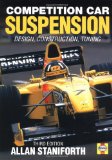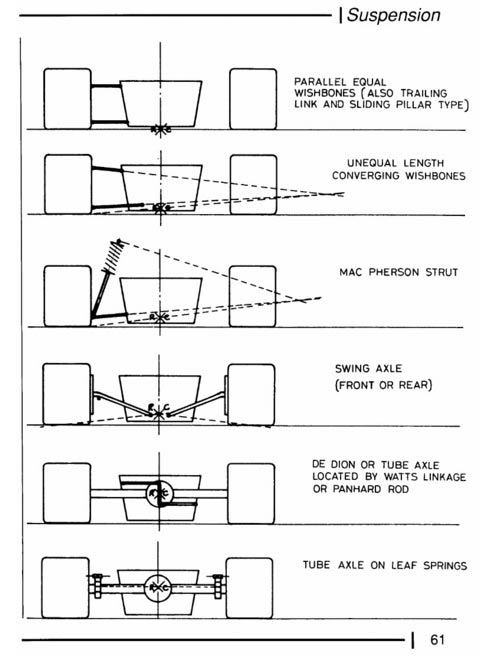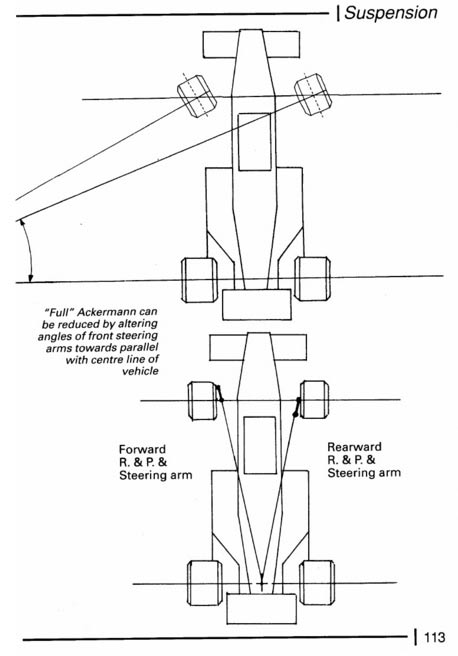Competition Car Suspension: A Practical Handbook

 (4/5) by
(4/5) by - All
- Dynamics/Handling ( Basic)
- Dynamics/Handling ( Advanced)
- Suspension ( Basic)
- Suspension ( Advanced)
Overview
Explains race car suspensions theory and design. The author explains the history of suspension design and types, handling theory, suspension design techniques, and the math/calculations used in design. The book also includes a unique string-based model approach to hands-on visualization of suspension movement.
Review
By Matt Gartner
Competition Car Suspension is a practical look at suspension history, types, theory and design. It provides enough discussion of each of these areas to leave the reader with a comprehensive view of the types, components and characteristics of suspensions.
The mathematics in the book are focused on weight transfer and forces and the design of suspension components to deal with these forces. Suspension geometry is not given calculation treatment, but is instead addressed by the author's "String Computer", which simulates the motion of a suspension using strings, rulers and templates. Aside from being hands-on, it does not require a computer software program, but because of this it also means "playing" around is much more labor intensive.
For the DIY designer, there is considerable information on the effects of different characteristics such as roll center, which is fundamental to suspension design. The book goes beyond theory in this regard and actually recommends/reasons the use of certain characteristic values. It also looks at many different configurations and layouts which are quite helpful to DIY designers in packaging their suspension.

The book does mostly focus its design examples on independent, unequal length wishbone suspensions, which are the preferred configuration of UK road racers and most Formula SAE/Formula Student cars. There are plenty of diagrams, photos and tables which are quite useful, especially in understanding the different suspension types and their layouts. Non-conventional spring types and suspension types are also discussed, so there are also plenty of innovative/historical ideas to consider.
Book Sections
Competition Car Suspensions includes the following sections:
History
The first section of the book deals with a history of suspensions, from horse-drawn carriages through to the modern day. It discusses advancements, the vehicles on which they were pioneered and the designers who created them.
Springs/Anti-roll bars
As a fundamental aspect of suspension, this section looks at the design and function of numerous spring types including leaf, torsion bars, rubber, air, oil and coil. The author discusses some of the multipurpose roles springs can play and the concept of spring rates.
The function and design of anti-roll (sway bars) is also discussed with a diagram and formulas for calculating the anti-roll bar size.
Coil springs, linkages and leverage ratios (rising/falling rate) are also considered, with calculations for the effectiveness of the coil spring.
Location
This section begins with suspension design goals and a look at the importance of roll center location. Different suspension types are discussed including parallel equal length, unequal length, swing axle, de Dion, and tube axle on leaf springs.
The front linkages of different types of suspensions, including beam axle, trailing arm, leading arm, sliding pillar, Mcpherson strut and wishbone variations are looked at next. The author discusses the important attributes and behaviors of each.
The same is done for solid live axle, De Dion, swing axle and wishbone rear suspension linkages.
Chassis pickup points and methods of spring actuation such as axle mount, rocking arm and push/pullrod are considered as well as the effects of inclining springs. A diagram and formulas enable calculation.
Components such as uprights, bearings and rod ends are also discussed and the author gives advice on the characteristics these parts should have.

Packaging/Design
Most of the book thus far has looked at the types and components of suspensions. This section begins to look at how to bring together the components into a successful package as well as the design attributes that must be considered. Topics include the effects on aerodynamics, uprights, brakes, unsprung weight, wheels, track/wheelbase ratio and steering. King pin inclination, caster angle and steering Ackerman are also discussed as well as anti-dive/anti-squat and brake reaction forces. In effect, the author covers the characteristics that must be designed for and provides advice on design goals.
Active/Reactive Suspension
This section devotes itself to the function, system and components of active suspension systems. Much of it shows historical systems. There are diagrams to show the overall systems and a discussion of the approach and goals of active suspension.
Pros
The author discusses some history of suspensions in professional racing in this section, primarily the various designs and their challenges.
Amateur
A recommended approach to suspension design for amateurs is discussed in this chapter. Beginning with the regulations and working up through the suspension (i.e. Tires-Wheels-Hubs etc..), the author looks at each design element and offers his best-practice advice.
Spring rates and suspension frequencies are considered and calculations are provided for the leverage created by different suspension types. Dampers are also looked at.
Weight Transfer
This section includes the most extensive formulas in the book around the transfer of weight, roll rates and roll resistance. The final calculations determine weight transfer to each corner of the vehicle, which in turn can be used to assess the natural understeer/oversteer characteristics of the vehicle.
Dampers
Damper characteristics, function and design parameters are also looked at. Calculations for damping are discussed and multiple flowcharts are provided for curing handling issues. These are probably one of the most useful aids in the book, as they follow the logic of diagnosing troubles.
Appendix
The final sections of the book look at the string computer espoused by the author, car setup, rod-end joints and a glossary.
Helpfulness to amateur race car designers
This book will certainly be of benefit to anyone considering suspension type and configuration choices, as well as those who are in the process of designing their own suspension. It gives a broad but practical understanding of suspension history, types, terminology and theory and expands on the positive and negative characteristics that each suspension type has. The book then looks at suspension components and their selection, design and desirable attributes in each. The design/packaging information presented in addition to the theory will enable DIY designers to calculate various important aspects such as springing and to establish a reasonable confidence in their design.



